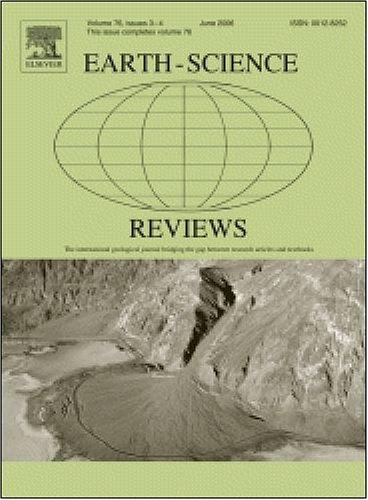Tectono-magmatic controls on porphyry Cu endowment in the Carboniferous Dananhu Arc, Central Asian Orogenic Belt: A review
IF 10.8
1区 地球科学
Q1 GEOSCIENCES, MULTIDISCIPLINARY
引用次数: 0
Abstract
Situated in the southwestern margin of the Central Asian Orogenic Belt, the Dananhu Arc is a prominent porphyry Cu belt in NW China. The Carboniferous granitoids that host two giant to large and several medium to small porphyry Cu deposits are concentrated in the middle segment of the arc. In contrast, coeval granitoids in the adjacent western and eastern segments are barren. The key factors controlling porphyry fertility and diversity in this arc have not been well constrained. The geochemical and Sr–Nd–Hf–O isotopic compositions of Carboniferous fertile and barren magmas exhibit systematic variations from west to east along the 600 km-long Dananhu Arc. Fertile granitoids have adakitic affinities, with high Sr/Y ratios, Mg#, and oxygen fugacity (ΔFMQ = +2.53 ± 0.52), and depleted Sr–Nd–Hf–O isotopic compositions. The barren alkaline granitoids in the western segment are characterized by enrichments in large ion lithophile elements, low Mg# and oxygen fugacity (ΔFMQ = +0.31 ± 0.11), and evolved Sr–Nd–Hf–O isotope compositions. The barren calc-alkaline granitoids in the eastern segment have low Sr/Y ratios, moderate Mg# and oxygen fugacity (ΔFMQ = +1.65 ± 0.50), and depleted Sr–Nd–Hf–O isotopic compositions. The fertile adakitic granitoids originated from partial melting of a flat-subducted oceanic slab accompanied by crustal thickening. The barren alkaline granitoids were derived from anatexis of accretionary complexes triggered by slab rollback accompanied by magma migration and crustal thinning. The barren calc-alkaline granitoids were derived from partial melting of the mantle wedge in a normal subduction setting. Taken together, we suggest that distinct tectonic settings generated the heterogeneous distribution of porphyry Cu deposits throughout the Dananhu Arc by controlling the nature of the magma that was generated.
中亚造山带石炭系大南湖弧构造岩浆对斑岩型铜赋存的控制
大南湖弧位于中亚造山带西南缘,是中国西北地区一条突出的斑岩铜带。弧中段石炭系花岗岩体集中分布有2个特大型斑岩型铜矿床和若干个中小型斑岩型铜矿床。相比之下,邻近的西段和东段同时期花岗岩类则是贫瘠的。控制该区斑岩繁殖力和多样性的关键因素尚未得到很好的约束。沿600 km长的大南湖弧,石炭系肥沃和荒芜岩浆的地球化学和Sr-Nd-Hf-O同位素组成呈现自西向东的系统变化。富育花岗岩类具有同源性,Sr/Y比值、Mg#和氧逸度高(ΔFMQ = +2.53±0.52),Sr - nd - hf - o同位素组成低。西段贫碱性花岗岩具有富集大离子亲石元素、低Mg#和低氧逸度(ΔFMQ = +0.31±0.11)和演化出Sr-Nd-Hf-O同位素组成的特征。东段钙碱性花岗岩的Sr/Y比值较低,Mg#和氧逸度适中(ΔFMQ = +1.65±0.50),Sr - nd - hf - o同位素组成较弱。肥沃的埃达克质花岗岩类起源于伴随地壳增厚的平俯冲大洋板块的部分熔融。贫碱性花岗岩类是由岩浆迁移和地壳减薄引起的陆块回滚引发的增生杂岩的深熔形成的。贫钙碱性花岗岩类来源于正常俯冲背景下地幔楔的部分熔融作用。综上所述,不同的构造环境通过控制岩浆的性质,形成了整个大南湖弧斑岩型铜矿床的非均质分布。
本文章由计算机程序翻译,如有差异,请以英文原文为准。
求助全文
约1分钟内获得全文
求助全文
来源期刊

Earth-Science Reviews
地学-地球科学综合
CiteScore
21.70
自引率
5.80%
发文量
294
审稿时长
15.1 weeks
期刊介绍:
Covering a much wider field than the usual specialist journals, Earth Science Reviews publishes review articles dealing with all aspects of Earth Sciences, and is an important vehicle for allowing readers to see their particular interest related to the Earth Sciences as a whole.
 求助内容:
求助内容: 应助结果提醒方式:
应助结果提醒方式:


